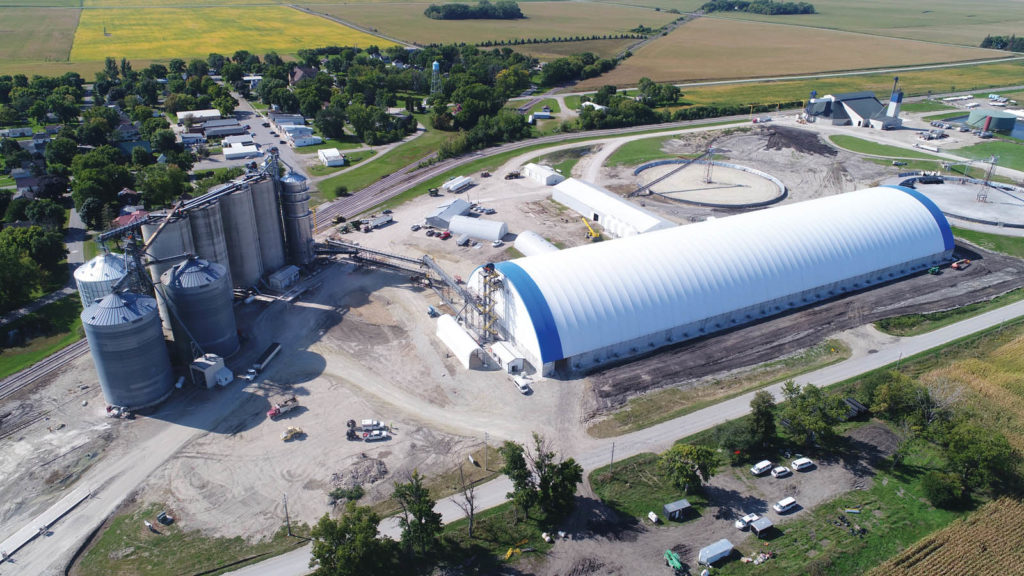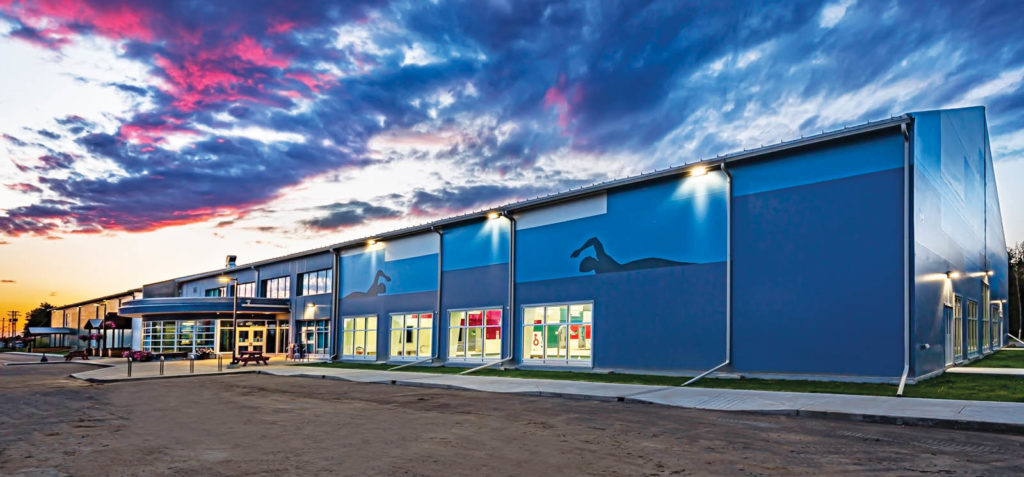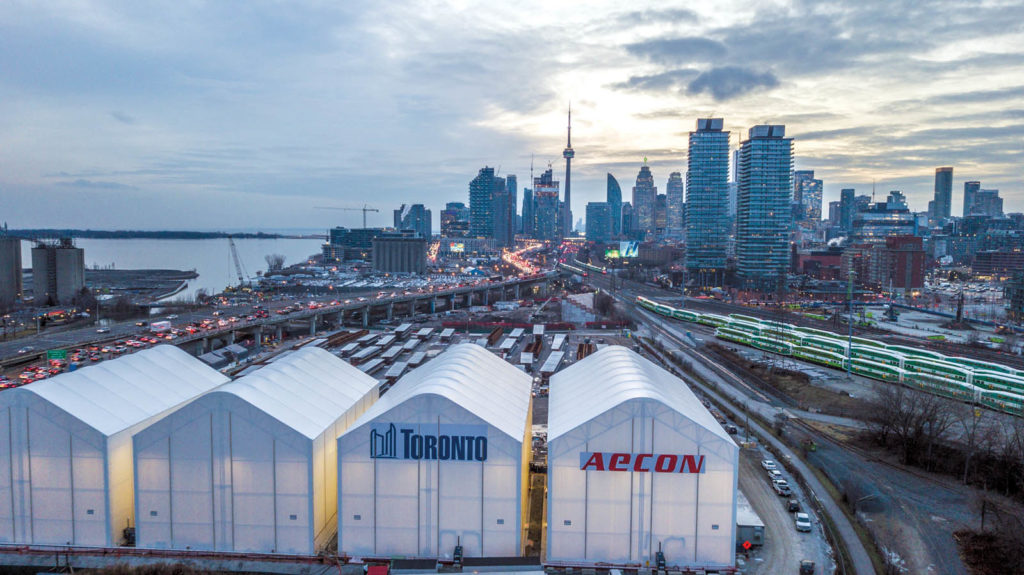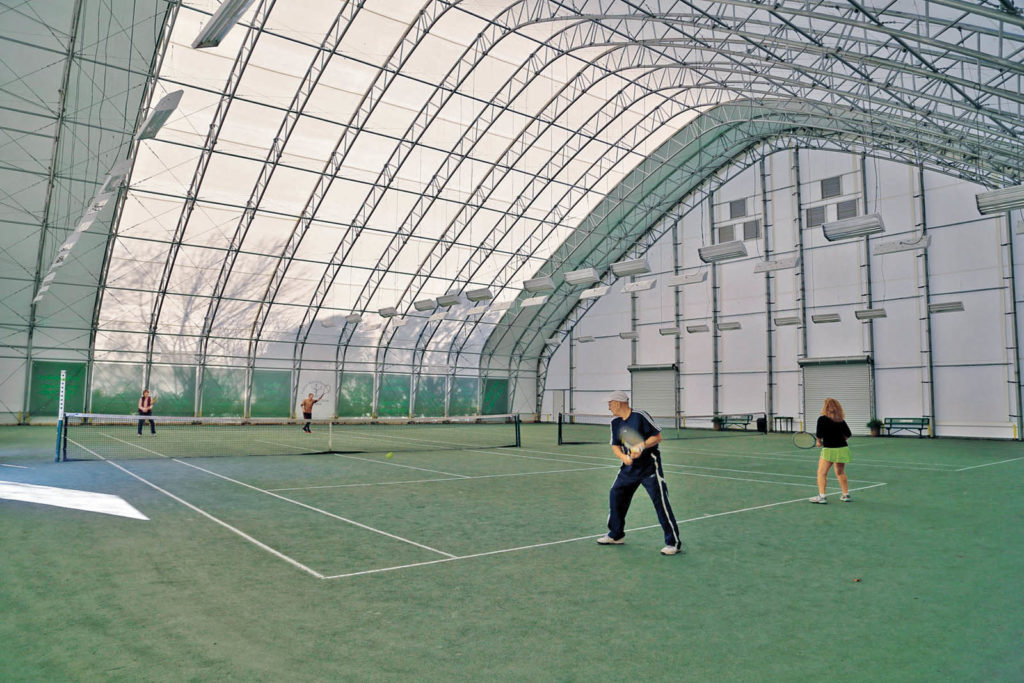
Successful businesses know that eco-friendly practices are part of sustainability, but creating long-term value is also key. More companies are choosing durable fabric structures to manage operating costs and reduce their impact on the environment, without sacrificing functionality.
Covering corn to fertilizer
In rural areas, fabric-covered structures are also becoming more common to house bulk commodities, from corn to fertilizer. “I’ve been encouraging the co-op to consider fabric buildings because these let you do more with less,” says Dale Vinsand, capital projects lead with Landus, a farmer-owned ag cooperative in Iowa.
Consider Landus Cooperative’s location at Rake, Iowa. Before August 2021, the co-op’s grain elevator along the Union Pacific Railroad consisted of 1 million bushels of grain storage in concrete and steel storage, plus a total of 2.7 million bushels of grain storage in three temporary grain storage piles.
Today, a new fabric building has replaced some of those grain storage systems. The structure, which measures 685 feet long and 180 feet wide, holds up to 4 million bushels of corn or soybeans. “This is a new move for Landus,” Vinsand says.
Landus hired Macon Construction from Bradford, Ill., to build the structure. The fabric roof covering is attached in separate pieces across the steel roof trusses, creating a continuous, waterproof connection between fabric and frame, without the risk of wear points on the fabric cover. “The fabric system is drum-tight, so the grain is protected from rain, snow and hail,” Vinsand says. “Round, smooth hailstones bounce off the fabric instead of tearing it.”
The fabric structure can also stand up to strong winds. “I didn’t lose any fabric tarps from the December derecho,” says Vinsand, referring to the derecho (like an inland hurricane) that generated nearly 90-mile-per-hour winds that ripped across Iowa on December 15, 2021.
For the fabric structure at Rake, Macon Construction added its patented MaconMaximizer™ technology that attaches underneath the building’s trusses to allow grain to be stored higher than the top of the concrete sidewalls, which are 17.5 feet tall. This increases the building’s storage capacity by up to 30 percent.
Economies of scale come into play when deciding whether to build a fabric structure, traditional metal grain bin or other grain storage option, Vinsand says. “If you need 2 million bushels or more of grain storage, it’s cost-effective to go with a fabric structure.” Landus Cooperative plans to add more fabric structures at some of the company’s other locations. “You need leaders who are willing to consider options beyond traditional commodity storage facilities,” Vinsand says. “Fabric buildings give us the extra storage space we need at a lower cost.”
A fabric structure like the one at Rake can be half of the cost of a steel grain bin, notes Nick Hoerr, vice president of business development with Macon Construction. Macon’s fabric structures work well for grain, fertilizer, salt, wood chips, fracking sand and other bulk commodities. “Our specialty is 1-plus million bushels of storage,” Hoerr says. “If it’s dry and granular, we can work with it.”
While Macon Construction has been working with fabric structures for years, they were a tough sell when Hoerr joined the company in 2012. “Flat” storage was an undesirable, four-letter word in the minds of many prospects and customers, Hoerr recalls. “They envisioned a dark, dingy building with steel columns everywhere.”
It was hard to deny the cost savings, however. “As more customers tried fabric structures, they liked the bright, safe work environment—and they like the fact that these buildings don’t break the bank,” says Hoerr.
Demand for fabric structures continues to grow. “Once a customer has one fabric structure, they usually hire us to build more of them,” Hoerr says.

Growing into the sports sector
Minnesota-based Legacy Building Solutions is seeing similar trends. “The demand for fabric buildings started to increase about 10 years ago,” says Eric Donnay, vice president of sales for Legacy Building Solutions, which works in the agriculture, equestrian, automotive, aviation, mining and military sectors.
The non-corrosive properties of the fabric cladding make them a long-lasting option when storing corrosive material, while the large clear spans of the buildings make them a cost-effective choice. “We have built structures ranging from 20,000 square feet to a few hundred thousand square feet,” Donnay says.
Each fabric cladding panel—typically 20 feet wide—is secured to the frame using a keder rail that slides horizontally on the top flange of the frame, eliminating the need to detach or flex frames during installation.
The fabric structures also allow daylight to brighten the interior. This is especially important for sports facilities, a sector that has become a bigger part of Legacy’s business in recent years. In addition to constructing a large sports complex in Canada, Legacy has worked with Martin Luther College in New Ulm, Minn., to build the Betty Kohn Fieldhouse, a 36,000-square-foot, indoor turfed facility with practice areas, baseball/softball batting cages, golf simulators and more.
“Fabric buildings like this are less expensive than brick-and-mortar structures and give you more square footage for the money,” Donnay says.

Designing high-tech fabric
Fabric innovations continue to make these structures more viable for a wider range of customers. Consider NovaShield® woven coated membrane structure fabric from Intertape Polymer Group (IPG), based in Montreal, Canada.
“There’s a constant demand for fabric that lasts longer,” says Carey Ewanik, product manager with NovaShield. “We offer a product that’s strong, lasts longer and is less expensive than traditional architectural fabrics.”
When IPG began selling NovaShield in the 1990s, it was primarily used in agricultural structures. As the technology evolved, IPG looked for ways to make NovaShield more durable, including enhanced UV protection for long service life. IPG offers NovaShield Elite with Armorkote™, a film-laminated fabric with greater durability and lighter weight.
“More customers also started asking for PVC-free options, which we offer,” Ewanik adds.
NovaShield is Cradle to Cradle Certified® at the Bronze Level, Ewanik notes. Cradle to Cradle is the global standard for products that are safe, circular and responsibly made. Certification denotes a continuous-improvement process based on five quality categories, including material health, material reutilization, renewable energy and carbon management, water stewardship and social fairness.

Strength and durability
Innovations in fabric technology are also important to ClearSpan Structures, which has worked in the fabric structure sector for more than 40 years. “Our fabric roofs are as secure as a steel roof,” says Geoff Ching, director of sales.
ClearSpan offers the Armor Shield Cover, a 29-ounce architectural vinyl building cover designed for maximum strength and durability.
While ClearSpan started in the agricultural market, it has expanded into commercial and industrial applications, including alternative energy vehicle testing and manufacturing. Bulk material storage is also big. “As ocean and river ports increase capacity to deal with supply chain challenges, our structures are a good fit,” Ching says.
Customers like the fact that a project can often be completed in six months or less. “Fast turnaround is helping drive the continued growth in fabric buildings,” Ching says.
Customers also like design flexibility. “With the width, we can span 250 feet or more,” Ching says. “The length is limitless. We can use welded truss frames, and we can build I-beam frames for any size you want.”
This value engineering, combined with the durability, sustainability and affordability of fabric structures, bodes well for the future, Ching adds. “No one likes to spend more than they have to. We see demand for fabric structures continuing to grow.”
Darcy Maulsby is a freelance wrter based in Lake City, Iowa.
 TEXTILES.ORG
TEXTILES.ORG


